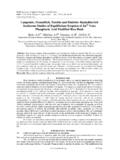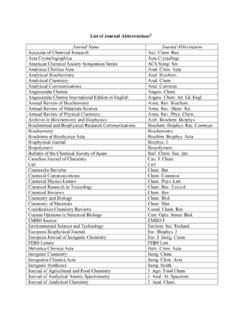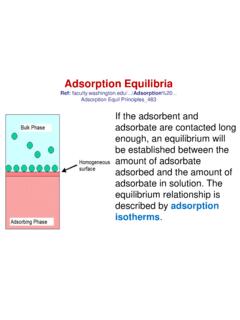Transcription of 5: Langmuir’s Probe - Tools for Science
1 5: langmuir s ProbePurposeThe purpose of this lab is to measure some basic properties ofplasmas: electron tempera-ture, number density and plasma you think of electrical conductors, you probably thinkfirst of metals. In metals thevalence electrons are not bound to particular nuclei, rather they are free to move throughthe solid and thus conduct an electrical current. However, by far the most common electricalconductors in the Universe areplasmas: a term first applied to hot ionized gases by IrvingLangmuir (see below). In conditions rare on the surface of the Earth but common in theUniverse as a whole, high temperatures1provide enough energy to eject electrons fromatoms.
2 Thus a plasma consists of a gas of freely flying electrons, ions, and yet unionizedatoms. It should come as no surprise that during the extraordinary conditions of the BigBang, all the matter in the Universe was ionized. About 380,000 years after the Big Bang,the Universe cooled enough for the first atoms to form. Surprisingly about 400 million yearsafter that the Universe was re-ionized, and the vast majority of the matter in the universeremains ionized today ( billion years after the Big Bang). Some of this ionized matteris at high density (hydrogen gas more dense than lead) and extremely high temperature atthe center of stars, but most of it is believed to be at extremely low density in the vastspaces between the the most obvious characteristic of conductors (metals and plasmas) is that theyare shiny; that is, they reflect light.
3 A moment s thought should convince you that this is1 What does hightemperature mean? When you are attempting to make a Bose condensation at lessthan a millionth of a degree, liquid helium at 4 K would be called hot. When you are calculating conditionsa few minutes after the Big Bang, a temperature of a billion degrees Kelvin would be called cool. Animportant insight: Nothing that has units can be said to be big or small! Things that have units need tobe compared to a normal state before they can be declared big or small.
4 Here the normal state refers toconditions allowing normal solids and liquids to exist. Tungsten, which is commonly used in the filaments oflight bulbs, melts at about 3700 K; Carbon does a bit better: 3800 K. The surface of the Sun at 6000 Khas no solid bits. At temperatures of about 5000 K most molecules have decomposed into elements whichin turn have partially ionized : ejecting one or more electrons to leave a positively charged core (an ion)and free electrons. I ll pick 5000 K as my comparison point for hot , but of course some elements ( ,sodium) begin to ionize a lower temperatures, and others ( , helium) ionize at higher temperatures.
5 Thekey factor determining the ionized fraction in the Saha equation is the first ionization energy .105106 langmuir s Probenot an all-or-nothing property. While metals reflect radio waves (see satellite TV dishes),microwaves (see the inside of your microwave) and visible light, they do not reflect higherfrequency light like X-rays (lead, not aluminum, for X-ray protection). The free electronnumber density (units: number of free electrons/m3),ne, determines the behavior of lightin a plasma. (Almost always plasmas are electrically neutral; , the net electric chargedensity is near zero.)
6 If the atoms are all singly ionized, we can conclude that the ionnumber density,ni, equalsne. In this lab we will be dealing with partially ionized argonwith a neutral atom densitynn ne ni.) The free electron number density determinestheplasma frequency, p: p= 2 fp=snee2 0m( )where eis the charge on an electron andmis the mass of an electron. If light withfrequencyfis aimed at a plasma: the light is reflected, iff < fp; the light is transmit-ted, iff > fp. Thus conductors are shiny only to light at frequencies below the plasmafrequency.
7 In order to reflect visible light, the plasma mustbe quite dense. Thus metals(ne 1028m 3) look shiny, whereas semiconductors (ne 1024m 3) do not. The plasmaat surface of the Sun (with ionized fraction less than 1020m 3) wouldalso not look shiny. You will find the plasma used in this lab has even lowerne; it will defining characteristic of conductors (metals and plasmas) is that they can conduct anelectric current. Since conductors conduct, they are usually at a nearly constant potential(voltage). (If potential differences exist, the resulting electric field will automatically directcurrent flow to erase the charge imbalance giving rise to the potential difference.)
8 Atfirst thought this combination (big current flow with nearly zero potential difference) maysound odd, but it is exactly what small resistance fact the detection of bigcurrents (through the magnetic field produced) first lead to the suggestion2of a conductorsurrounding the Earth an ionosphere. Edward Appleton (1924) confirmed the existenceand location of this plasma layer by bouncing radio waves (supplied by a transmitter)off of it. In effect the ionosphere was the first object detectedby radar. Appleton s earlywork with radar is credited with allowing development of radar in England just in timefor the 1941 Battle of Britain.
9 Appleton received the Nobel prize for his discovery of theionosphere in 1947. (Much the same work was completed in thiscountry just a bit later byBreit & Tuve.)The plasma frequency in the ionosphere is around 3 10 MHz (corresponding tone 1011 1012m 3). Thus AM radio (at 1 MHz) can bounce to great distances, whereas CBradio (at 27 MHz) and FM (at 100 MHz) are limited to line-of-sight. (And of coursewhen you look straight up you don t see yourself reflected in the ionospheric mirror, asflight 5 1014Hz. On the other hand, extra terrestrials might listen to FM and TV, butwe don t have to worry about them listening to AM radio.)
10 The actual situation is a bitmore complex. In the lowest layer of the ionosphere (D region), the fractional ionizationis so low that AM radio is more absorbed than reflected. Sunlight powers the creation ofnew ions in the ionosphere, so when the Sun does down, ionization stops but recombinationcontinues. In neutral-oxygen-rich plasmas like the D region, the plasma disappears withoutsunlight. Higher up in the ionosphere (the F region, whereneis higher andnnlower) total2 Faraday (1832), Gauss (1839), Kelvin (1860) all had ideas along this line, but the hypothesis is usuallyidentified with the Scot Balfour Stewart (1882).









